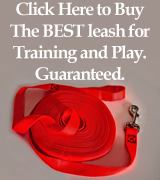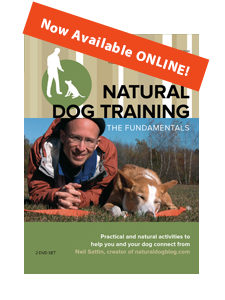Having covered lots of training ground, I thought this might be a good time to talk about a structure for your training sessions. With a proper training plan you can cover all of the bases in a relatively short amount of time: working on obedience, addressing any problems you might be having, and giving your dog a healthy amount of exercise (both physical and emotional). In case you were wondering how it all fits together, my goal for this article is to give you a clear picture of what a typical training session might look like for you and your dog. Plus, with the holiday weekend coming up (it's Thanksgiving week here in the U.S.) you're going to have lots of time to focus on training with your dog, right?!?
A Typical Session of Natural Dog Training: First things first
- Prepare. Preparations involve having tasty treats in an easy-to-access pouch, your long training leash, and whatever other equipment you think you're going to need (tug toys, training box, flat collar, etc.).
- Time. Since I generally use food during training sessions, I like to train dogs around mealtimes. If you can spend 20 minutes in the morning and 20 minutes in the evening of focused training time with your dog, you'll have a happy dog on the route to being well-trained. Any additional time is bonus (like if you're taking your dog along for a jog, for instance).
- Assess. Take your dog outside. Remember that almost all training (except for those things specifically designed to happen inside) should happen outside. Think about how your dog has been lately. Have there been any notable improvements? Any obstacles? Do you feel like you're getting 100% of your dog's energy yet, or is your dog still holding back? How much energy can your dog handle while staying relaxed, and at what point does your dog tense up? And how about you - have you been able to stay calm while working with your dog and helping your dog interact with the world? Are you remembering to check in with yourself while you train? And have you been able to focus, non-judgementally, on your dog's experience, to seize moments of opportunity as you're out in the world?
"Formal" Training time - play with it to get something that works for you
- Play fetchtug. I'll start with tug-of-war, and then I'll transition to fetchtug. The goal is to just get your dog's energy flowing. Intersperse fetchtug with encouraging your dog to chase you around as much as possible. You can also toss out a surprise treat here and there, to keep it even more engaging. After about 5 minutes (tops) you'll want to transition to
- Pushing. You can learn how to push from this article. You can learn why to push from this article. Spend about 5 minutes on pushing with your dog, starting with smaller pushes, and gradually building up to your dog's threshold for pushing. REMEMBER NOT TO EXCEED YOUR DOG'S THRESHOLD. It's just like lifting weights - use the largest weight (push) you can without injuring yourself (pushing so hard that your dog backs away from you). Over time your dog's ability to push will increase.
- Box-work. Spend another 5 minutes doing work on and off the box. At this point we've covered "sit" and a low intensity "stay" on the box, along with using pushing to get your dog off the box. I'll add links to other box techniques as we cover them on the blog.
- Cool down. Now it's time to help your dog get as relaxed as possible. Spend your last 5 minutes massaging your dog. Stay quiet, and see if you can get YOURSELF into a relaxed, meditative state while you work on removing all the physical tension from your dog's body with gentle touch. You are your dog's massage therapist - make sure your touch is relaxing and not stimulating.
- Head inside - you're done!
Training "in the field"
Assuming that you're going to take your dog on at least one walk per day, make sure that you're familiar with the exercise on how to redirect an excited or aggressive dog, and use it to reinforce your "moose-ness" in your dog's eyes as you walk around the neighborhood.
Specialized work
If you have problems that you're working on, you can find specialized exercises on this blog (try the solving problems category for starters). You can work those exercises into your daily training sessions, or you can set up special times, when it's convenient for you, to work on those exercises. The important thing is for you to ensure that you have the proper time to focus on the work that you're going to do with your dog, and, especially after the specialized exercises, to make sure that you have time to help your dog relax, through tug of war and massage (along with the other techniques we've discussed), at the end of your session.
I hope that this has given you a good start on a structure for how to work Natural Dog Training into your life with your dog. As I add new exercises on the blog, we'll discuss how they can be incorporated into your existing routine. Remember, it's not the quantity of time that matters - it's the quality! Think about your training plan, create a structure for yourself (and your dog), and do your best to stick to it consistently. Your dog will be very grateful, and you'll notice a constant evolution in your progress together.
And speaking of gratitude - thank you to all of you who are visiting the NaturalDogBlog. I appreciate your feedback, questions, and participation in making this one of the most informative (and practical) Natural Dog Training sites on the web. You've helped to make my first few blogging-full-time months really fantastic, and I am most appreciative.





We have lab puppy that is beyond our control. We have an 8 yo lab female, so picked out the male puppy of litter. Dogs are getting along great -but these dogs give us no rest. They're too clever...
tried shutting off water-access- now the pup whines beside our bed and scracthes.
-puppy has to go out and we take him. We only get 4 or 5 hours of sleep but we take them.
Hi Kevin,
Just take it slow, and be methodical in your approach. Having two dogs is often more than twice the work (as I've stated elsewhere), but there's light at the end of the tunnel. If you stick with it, eventually your pup will settle down, you'll be able to redirect all that energy into positive behaviors, and order will be restored to your household.